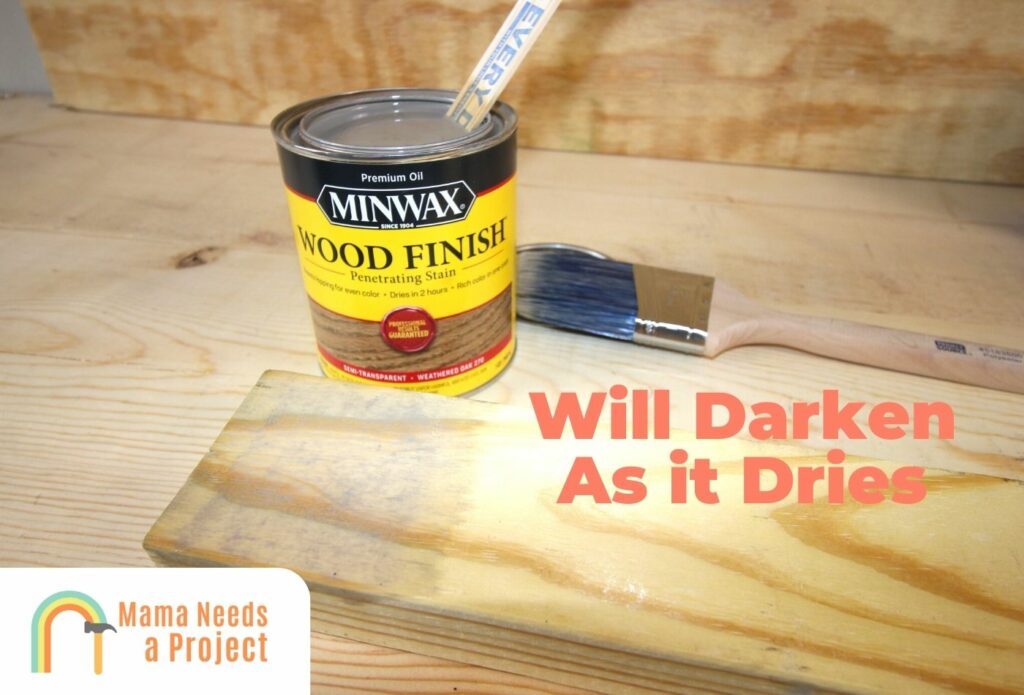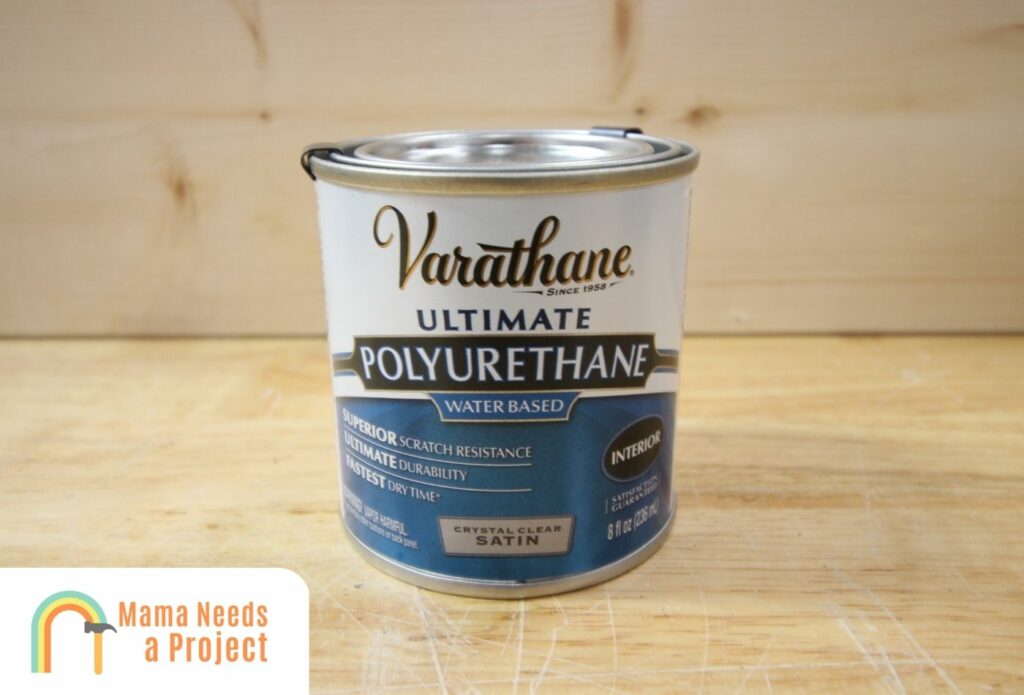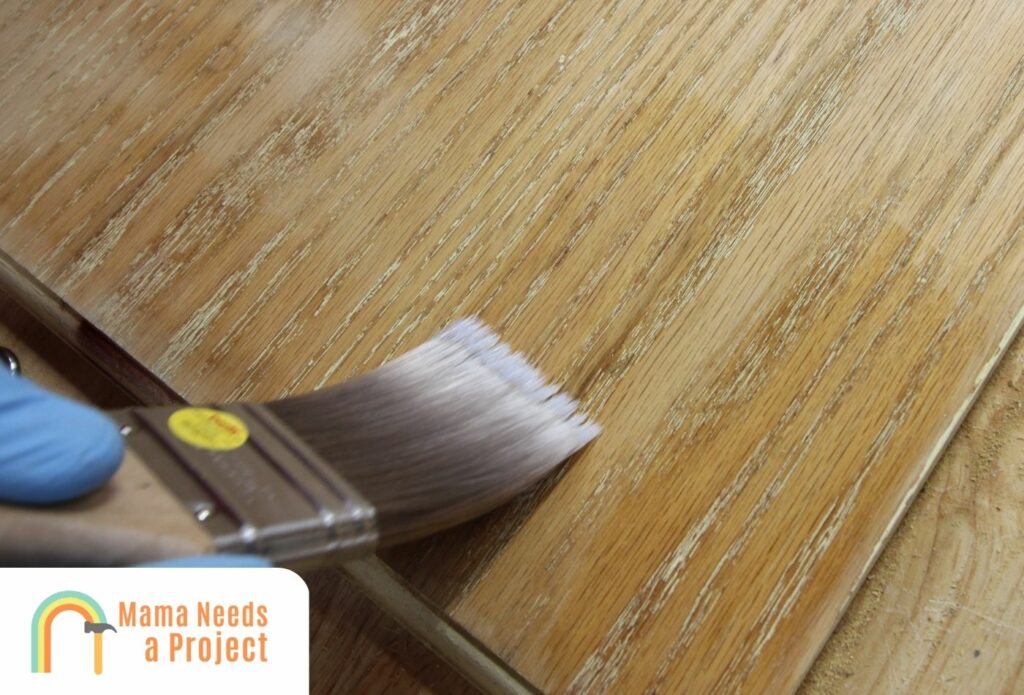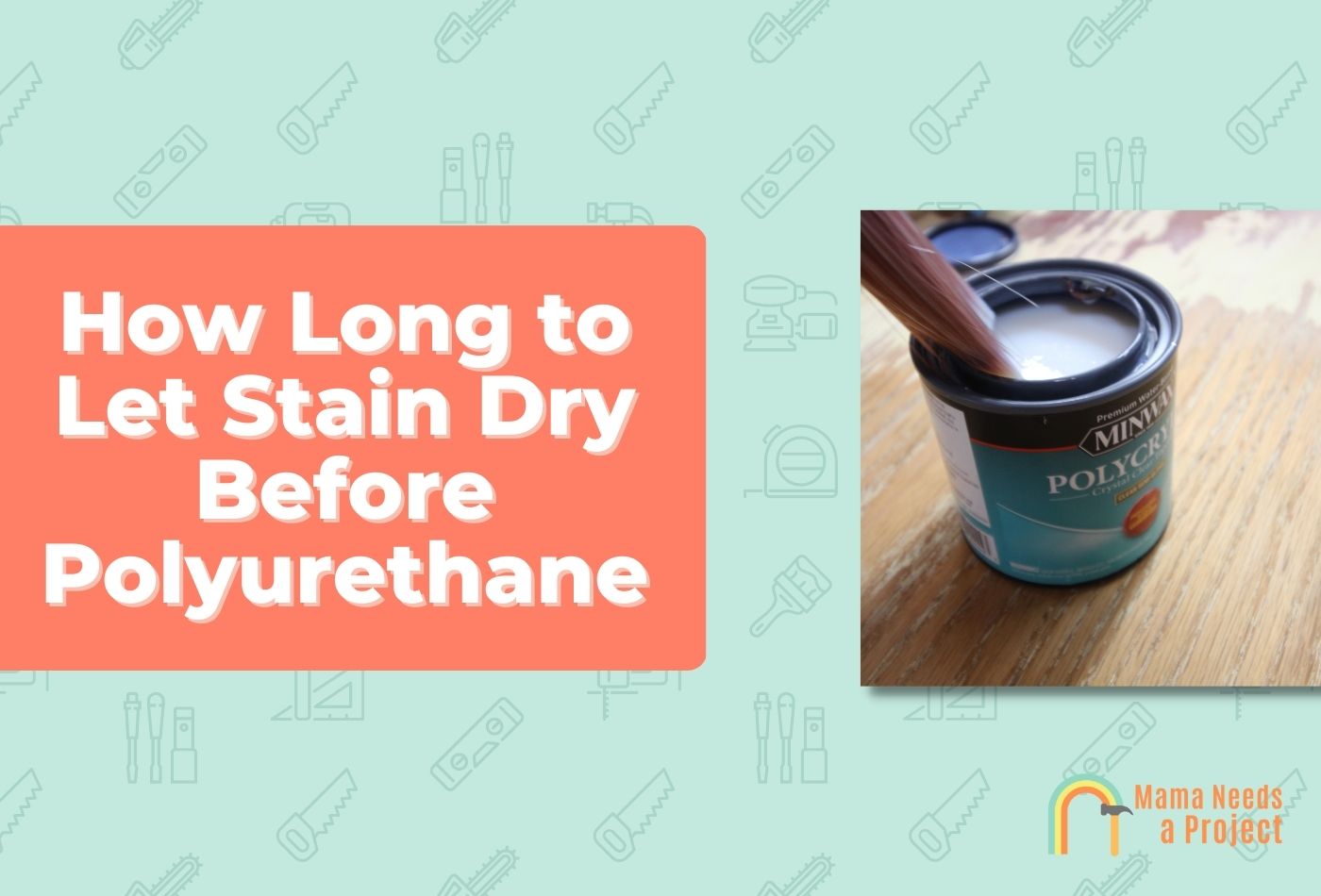How Long to Let Stain Dry Before Polyurethane
Wood stains and polyurethane are two common finishes used on wood for protection and visual appeal.
But how long should you let stain dry before polyurethane?
In this post, I’ll explore both oil based wood stains, water based stains, and how long you should let each dry before polyurethane.
- Oil-based and gel stains take 5-6 hours to dry, but many woodworkers allow these stains to dry overnight just to be safe. Water-based stain, on the other hand, dries in 1-2 hours; but some water-based polys can dry in just 30 minutes.
- The time it takes wood stain to dry is determined by a range of factors, and the drying process can be accelerated. It’s best to wait a full day before applying polyurethane over wood stain to ensure it’s dry.
How Long Should Oil-Based Wood Stains Dry Before Applying Polyurethane?
Give oil-based stain at least six hours to dry before applying polyurethane. That said, if the stain still looks wet after six hours of drying, wait at least 2-4 hours before checking again.
Or you could make things simpler and just give the wood stain 24 hours to dry. In fact, a lot of wood stain manufacturers recommend doing so.
Personally, I like to give oil-based stain plenty of time to dry (at least 24 hours) since it’s thicker and easier to mess up. And if you do mess up, i.e. apply polyurethane too soon, you’ll be spending the next half hour correcting that mistake.
Why Does Oil-Based Wood Stain Take Longer to Dry?
Because it’s more viscous, oil-based wood stain takes longer to seep into the wood pores. The drying process can be accelerated, but I’ll address that later.
The time it takes an oil-based stain to dry is largely determined by its makeup. Also, temperature and humidity in the area where the stain is drying are relevant.
You can buy a quick-drying oil-based stain, but it may not be as durable as a stain that takes longer to dry. This is because quick-drying products are often thinner.
How you apply oil-stain is also relevant. If you apply it with a brush or roller, there’s a greater risk of applying too much stain – which will take longer to dry.
If you apply it with a sprayer, this risk is greatly reduced, provided you know how to use this tool.
But spraying oil-based wood stain isn’t ideal since this usually requires thinning beforehand, and if you don’t get the balance right you could spray out a poorly mixed stain that ultimately flakes off shortly after drying.
Applying Oil-Based Stain: Indoors vs Outdoors

It’s best to let oil-based wood stain dry indoors in a well ventilated room, since here it won’t be exposed to the elements. But if this isn’t possible—like when staining a deck—wait for a multi-day stretch of dry weather.
Partly cloudy days are the best, since there’s usually just enough sunshine to move the drying process along. A three-day stretch should provide enough time to apply stain and poly.
How Long Should Water-Based Wood Stains Dry Before Applying Polyurethane?

Water-based wood stains usually take 1-2 hours to dry.
They dry faster because they don’t have a thick consistency like oil-based stains, and since they’re applied in thin coats you don’t have to worry all that much about excess stain, unless you really go overboard when applying the stain.
Although this wood stain dries faster than oil-based stain, it’s not as durable, which means you need to be extra careful when roughing it up before the poly application; you could take too much stain off if you apply too much pressure when sanding.
The drying process for water-based stains can be sped up, but there’s a greater chance you’ll distort the stain if you’re not careful; the same can’t be said for oil-based stains.
Check out this guide to staining over polyurethane to learn everything you should know!
How to Know Wood Stain Is Ready for Polyurethane
The best way to tell if wood stain is dry enough for poly is the “touch test”. Basically, if you touch the stained wood and it still feels wet, it’s best to let it dry more.
If you don’t want to touch the wood stain because you’re afraid you’ll mess it up, use the “eye test”. Does the stain look shiny? If so, it’s probably still mostly wet. This test isn’t as reliable as the touch test.
There’s also the “smell test”, but this really only applies to oil-based wood stains since water-based wood stains don’t really have a smell. Basically, if there’s a strong odor emanating from the stain, it needs to dry longer.
You can use the same test to help you determine whether or not polyurethane is dry, since both polyurethane and wood stain emit odors while drying.
However, poly’s odor is a lot stronger and therefore more toxic, so using this test without proper protective gear isn’t advised.
Factors That Affect Drying Time

Type of Stain Used
Some stains are quick-drying while others have components that slow down the drying process. If you’re using oil or gel stain, expect the drying process to be on the longer side.
Weather & Humidity
Weather and humidity significantly impact the wood stain drying process.
Especially if stain is drying outside, it’ll be at the mercy of the weather and elements.
This is why you should wait for a stretch of good weather before applying wood stain to outdoor wooden furnishings and structures.
Rain, snow, and even wind can negatively affect drying stain.
Humidity won’t necessarily distort wood stain, but it can elongate the drying process; this is especially true for the stains that take longer to dry, i.e. oily and gel stains.
Type of Material
The kind of material being stained is relevant as well.
Softwoods are easy to stain because they have larger pores and they’re not as dense. Hardwoods, on the other hand, take longer to stain because they’re thick with many tiny pores.
Also, it’s harder to stain naturally moist and oily woods.
Amount of Stain Applied
It goes without saying, but if you apply multiple layers of stain, the overall drying process is going to take longer than if you just applied one thin coat.
Rarely is one coat of stain adequate, even if you’re using oil-based or gel stain.
It usually takes a day for multiple coats of water-based stain to dry, whereas it may take a few days for oil-based and gel stains to dry completely.
Want to darken wood without using stain? Check out these amazing ways to darken wood without wood stain!
What Happens if You Don’t Let Stain Dry Before Applying Polyurethane?
If you don’t let wood stain dry for a sufficient amount of time, the polyurethane will not adhere to the wood’s surface well, and eventually it’ll “dry” just to flake or peel off soon after.
Applying poly too soon can also discolor the stain, in which case you’d have to remove the poly and the stain to correct the issue.
And once polyurethane has been applied to wet wood stain, expediting the drying process won’t do any good; in fact, it’ll probably make things worse.
Even though polyurethane doesn’t seep into wood’s pores like stain does, it still needs to be able to form a bond at the surface level, which it won’t be able to do if there’s wet stain between it and the wood’s natural surface.
How to Make Wood Stain Dry Faster
Use a Heat Gun or Hair Dryer
A lot of woodworkers reach for a heat gun or hair dryer when they want wood stain to dry quicker, and while these tools can speed up the drying process, they can also prevent the stain from drying properly if they’re not used correctly.
For one, you need to avoid using a heat gun or hair dryer immediately after applying stain. This is because stain needs time to soak into the wood pores.
Instead, a heat gun or a hair dryer should be used when it seems the stain is mostly dry.
Important: You shouldn’t blast the stain with hot air at close range, as doing so can discolor the stain or cause it to peel soon after.
Open Windows & Run Fans

Opening windows and running fans to improve ventilation and airflow in the room where wood stain is drying can also speed up the drying process.
It’s good to have a floor or desk fan running in combination with an overhead fan, and at least one window should be open to ensure a constant stream of fresh air.
Just make sure the window has a screen, as you don’t want debris blowing in from outside and landing on the drying stain; it could get stuck there and prevent a sound finish from developing.
Run a Dehumidifier
Running a dehumidifier can also speed up the process. A high amount of humidity can prevent wood stain from drying quickly, but a dehumidifier would prevent this scenario.
Specifically, a dehumidifier can help both oil-based and latex wood stains (water-based).
But sucking the moisture out of the air this way, especially if it’s done for too long, could result in tacky stain, which is neither visually appealing nor sturdy.
That said, if speeding up the stain drying time process is vital, run a humidifier in conjunction with a few fans; doing so can get the stain dry 20 to 30 minutes quicker.
Apply Thin Coats
Applying thin coats of wood stain—whether you’re using oil-based or water-based stain—is smart if you want the stain to dry quickly.
After all, the thicker a coat of stain is, the longer it’ll take to dry.
Also, if there’s a lot of excess stain, this probably won’t dry at all, preventing the stain from being sandable until it’s removed. Then polyurethane can be applied.
Lastly, just because you’re applying thin coats doesn’t mean the stain is going to be dull; all you need to do is apply the right number of coats:
- 2-3 for oil-based stain
- 5-7 for water-based stain
How to Ensure Poly Adheres Properly to a Wood Surface After Staining
If you apply polyurethane to a wood surface that’s been stained recently and you don’t like the results you achieve, it may not be the stain’s fault. It could be that you applied the poly improperly.
Applying poly can be difficult if you’ve never done this before, so if you make a mistake the first time around don’t worry; most poly mistakes are easy to correct.
Once the wood stain is dry, you should do some light sanding; the goal here is to rough up the surface so the first polyurethane coating can adhere properly.
Don’t sand with too much force, otherwise you could remove too much material from the wood’s surface.
If you’ve sanded correctly, the poly should adhere and eventually dry completely, and there shouldn’t be any flaking, peeling, etc. once the poly is completely dry.
Drying vs Curing
The time it takes a wood stain to dry is shorter than the time it takes stain to cure.
When a wood stain is considered “dry”, this means the water or solvents in it have evaporated, leaving behind the pigment which gives the stain its color. When a wood stained is “cured”, this means the pigments have gone from liquid to solid.
You don’t have to wait for a wood stain to be completely cured before staining it. In fact, it’s best to apply poly before the stain has had a chance to cure completely, as this way both finishes can cure together, leading to a stronger bond.
Final Thoughts on How Long to Let Stain Dry Before Polyurethane
Whether you’re using water-based or oil-based stain, you need to allow sufficient time for drying before applying polyurethane, otherwise the stain and the poly will suffer.
Wait at least 1-2 hours for water-based and at least 6-24 hours for oil-based.
Dry stain takes poly much better than wet stain, and if you don’t apply poly too early you’ll avoid an annoying correction process.

